#16th c. Flanders
Photo
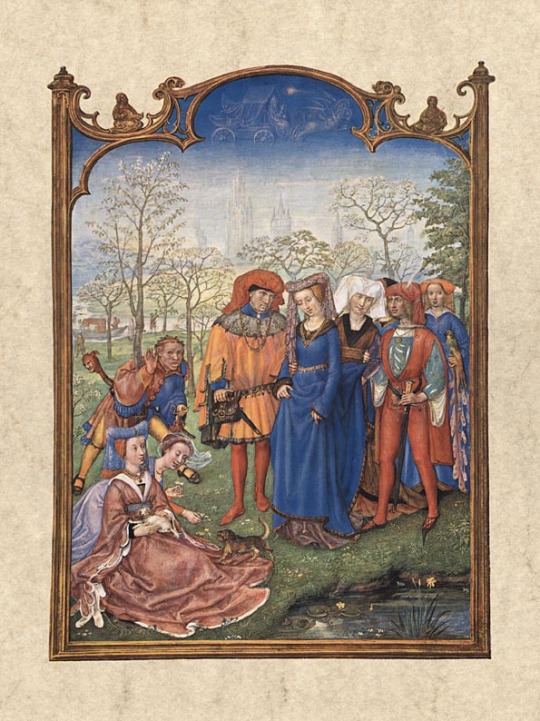
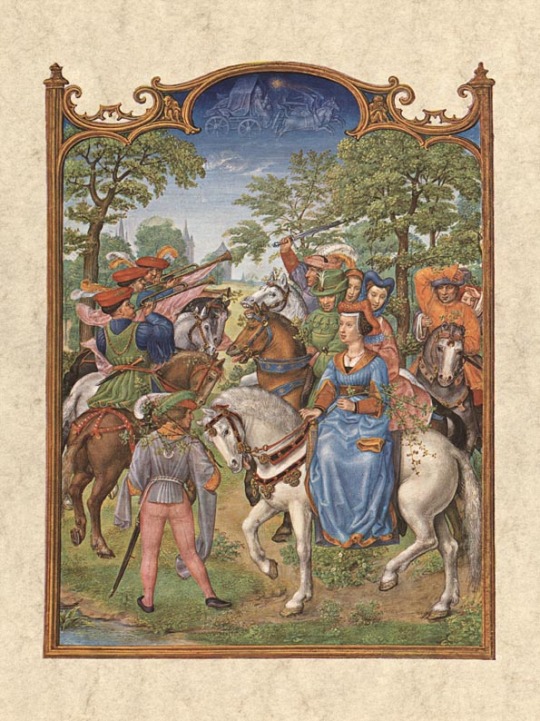
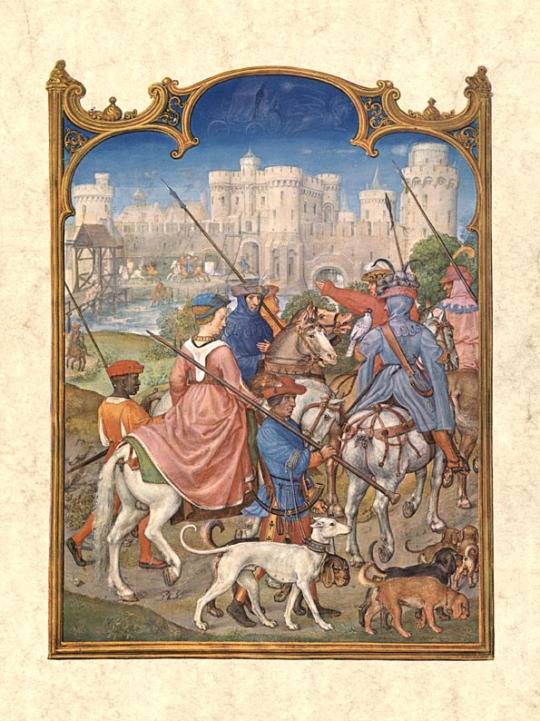
The months April, May andd August from the Grimani Breviary by Gerard Horenbout, Alexander and Simon Bening, c. 1510; Flanders
#1510s#illustrated manuscript#manuscript#16th century#mdp16th c.#flanders#16th c. flanders#gerard horenbout#simon bening#alexander bening#early 16th century
304 notes
·
View notes
Text

egg/goat creature
from the "book of hours of nicolas of firmian", flanders, 16th c.
source: Berlin, SBB, Hdschr. 241, fol. 209r
#16th century#marginalia#hybrids#goats#eggs#hens#book of hours of nicolas of firmian#nicolas von firmian#illuminated manuscript
251 notes
·
View notes
Text
Today's #YearOfHours is Lehigh Codex 19, a book of hours, use of Rome. It appears to have been produced in Flanders in the early 16th c. for a member of the Ayala family in Spain, as it contains a coat of arms identifiable with this Spanish family as well as Spanish rubrics for a series of fifteen unusual prayers that appear to be associated with Giles of Rome.
🔗:
#manuscript#medieval#book history#rare books#medieval manuscript#illuminated manuscript#16th century#illumination#illustration#book of hours#year of hours#flanders#spain#art history
34 notes
·
View notes
Text
A Flemish Classic: Carved Oak Panels
A popularity from the 17th century, Flemish furniture showcased a distinctively elaborate carving style, primarily on oak wood as the base. This oak wood furniture has a wonderfully ornate aesthetic and was often heavy duty and durable. So much so that examples from the yesteryears are wonderfully preserved till date and can infuse the same appealing charm that they did during their olden days.
The signature Flemish furniture was a product of the master craftsmen of Flanders (Belgium). It was usually included in Dutch Renaissance furniture and wasn’t necessarily defined as a distinguished period of furniture. Flemish furniture which drew influence from the French designs went on to be an influence in design rather than being a design period in itself.
The Flemish scroll was one of the most distinguishing elements of this furniture style apart from its ornate beauty. The S or C curved ornamental form was a common feature which often would be broken by an angle. The Flemish foot was again a scroll-like ending to an S or C curved leg.
A classic belonging to this design style at Period Oak is this substantial pair of 16th century deeply carved oak panels, depicting St John the evangelist and St Mathew. This fine pair of oak panels are carved within an arch flanked by columns with corinthian capitals and renaissance floral decoration. A stunning decorative pair in wonderful colour and patination. An absolute collector’s piece, this is the kind of decorative accessory that will beautifully grace the space of an avid antique connoisseur.
Have a look at this classic right Here!
0 notes
Photo
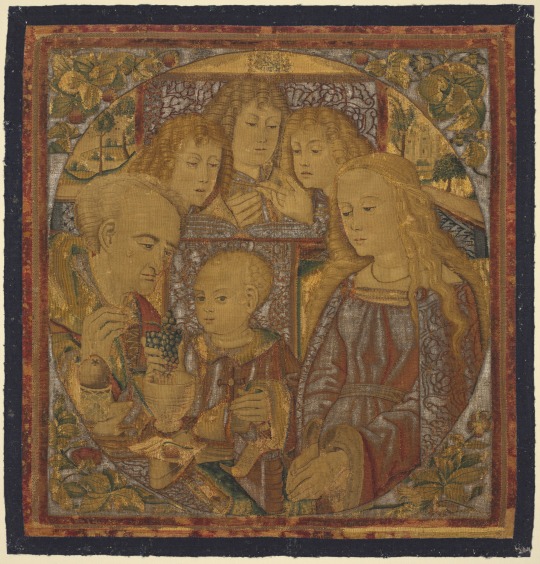
The Mystical Grapes
c. 1500
Flanders, possibly Bruges, early 16th century
https://www.clevelandart.org/
7 notes
·
View notes
Text
Calendar of State Papers Foreign: Edward VI 1547-1553
1549.
1548–9. Jan. 4.
(Brabant style.) Antwerp. The Magistrates of Antwerp to the Lord Protector and the Council. Their intervention has been besought by James Van Maseyck and Hubert Calnwaert, their fellow-citizens, in behalf of their partner and other fellow-citizen, William Van Eertwyck, who has been arrested in London, and is in danger of his life for having in his possession letters of licence from his Majesty, ascertained to be forged, but which he purchased in ignorance thereof for the sum of 100 pounds of Flanders money from Bernard Rubiis, public money-lender here. Send herewith certified copies of the judicial proceedings against the said Bernard Rubiis, and requesting that suit against Eertwyck may be stayed, &c. [Latin. One page.]
---
Jan. 7.
Antwerp. Batoryk [Borthwick ?] to the Lord Protector. Refers to some marriage and exchange of property. The French king makes certain preparations for the defence of Scotland. Propounds a plan for eradicating Papismus by transferring the Kirklands to gentlemen's hands. Intends to depart to-morrow, and to get favourable letters from the King of Denmark to the French King to deliver the gentlemen of the castle of St. Andrew's according to the promise made to them by the Prince of Capua. [One page and a half. Much effaced by damp.]
---
Jan. 10.
Brussels. The Emperor Charles V. d notre tres chier et bien amé Messire Guillme Paget, Chev de lordre et Contreroler d' Angleterre. Credentials of M. Francis Vanderdilst, his Ambassador, on resuming his functions in England. [One page.]
---
Jan. 17.
Augsburg. Same to King Edward VI. Supporting the claims of certain citizens of Lubeck for the value of a vessel impressed by King Henry VIII. during his war with the French King, and for which indemnity had been promised. [One page.]
---
Jan. 20. Instructions for John Dymock sent to the Duke of Lunenburg, the Count of Oldenburg, and others, for the purpose of levying more soldiers under Courtpening. His Majesty offers to bestow on the Duke and the Count a pension of 1,500 crowns each, and has taken the son of the former into his service, and to be trained in his Court, with a pension of 500 crowns. [Sixteen pages. Draft.]
---
Jan. 24.
Bremen. The Senate of Bremen to King Edward VI. Their reply has been communicated in writing to John Brend, his Majesty's Ambassador. They will take care that none of their citizens shall supply the Scots with munitions or provisions; reserving, however, their traffic with Ireland. Request the loan for a few years of 5,000 or 6,000 talents sterling. [Latin. One page.]
---
Jan. 25.
Brussels. Emanuel Philibert, Prince of Piedmont and Duke of Savoy, to the Lord Protector. Recommends the bearer, Aleram, son of Boarel, Marquis d'Ancise, one of his vassals, who desires to be employed in the service of the King of England. [French. Broadside.]
---
Jan. 31. Gaspar de Figueredo, Portuguese Ambassador, to the same. Complains that a person from whom he had hired a house will not give him possession, and requests his Grace's interference. [Latin. One page.]
---
Feb. 23.
Paris. Dr. Wotton to the same. On the 1st of this month the French Queen was brought a-bed of a fine boy. Hears that the King of Portugal, the Duke of Ferrara, and the Queen Dowager of Scotland are to be his sponsors; and that the King has sent expressly to the Emperor and the Bishop of Rome to intimate the birth. Monluc, who it is said is to be President of the Council in Scotland, has not yet left. M. de Thermes is here also, but reported as soon to go to Scotland, and M. d'Essé is to come home.
Divers captains come out of Provence for Scotland. Pietro Strozzi is at the Court again. Hears that the French King has news of the safe arrival of the Provenceaux in Scotland, and that in the beginning of next March 2,000 more men are to be sent there.
It is said that Berwick, which they reckon easy to be won, is to be besieged the first thing this year. Hears that the French King has renewed a league with the Swiss. Of late has been a great fray in this Court, connected with the rival claims of the families of De la Val and Andelot to the inheritance of certain estates, the particulars of which he gives at length.
Had on the 11th received his Grace's letter of the 3d inst. Fitzgarret being still about the Court, the bearer of this, Henry King, brought the priest to him; what they have done and how they have sped, they can best declare to his Grace.
Had spoken with Fitzgarret at his earnest desire; if his tongue and his heart agree, he is most anxious to return home. Trusts that his conversation with him may have somewhat confirmed him in that purpose, and he would fain it might be very shortly, for such causes as the said priest can declare unto his Grace.
Fitzgarret himself says that undoubtedly the French King sends another aid to Scotland next month, and those that are to go are hasted to Brittany. [Three pages; partly in cipher, deciphered. Printed by Tytler, except the portion in cipher, Vol. i., p. 156.]
---
March 24.
Hamburg. John Dymock to the Council. Has been requested by some Lords of this city to introduce the bearer, who seeks redress for articles taken from some merchants here by Sir Andrew Dudley, whose note of hand bears that they were taken for the King's use.
Unless this is seen to, does not see how he can procure any ships for the King's service, so many similar grievances being complained of. Enumerates the articles and the ships from which they have been taken. [Two pages.]
---
March 24.
Hamburg. John Dymock to the Lord Protector. The Earl of Oldenburg will not serve for less than what he received from the French King, viz., 2,000 crowns for himself, and the same sum for the entertainment of 12 captains. Thinks the Earl of Mansfeldt and his son have persuaded him to this. Had been to the Duke of Brunswick at the castle of Harburg on the 18th; after much persuasion he agrees to serve for 1,500 crowns. Determined opposition to the Interim in these parts. Necessity for increasing the pay of the mercenaries. Question as to the transmission of horses and men to England. The city of Wittenberg and castle of Turgo have been delivered to King Ferdinand by Duke Maurice. [Four pages. Partly printed by Tytler, Vol. i., p. 161.]
---
1549. March 25.
Hamburg. Same to the Lord Protector and the Council. As to the seizure for his Majesty's use of a vessel laden with salt fish belonging to some merchant of the Hanse Towns. [One page. Much defaced.]
---
March 28.
Hamburg. Same to same. Sends by a special messenger to ascertain their pleasure on the various points contained in his letters of 16th and 24th inst., and recapitulates at great length his interviews and negotiations as to supply of ships and men. [Six pages and a half.]
---
April 6.
Westminster. The Council to Sir Philip Hoby. Had received his letters of 31st March and 1st and 2d April. Are much gratified by the Emperor giving licence for soldiers to enter the King's service, his evil taking of the Frenchmen passing through his pale, and his promises of support in case of any invasion by the French.
Desire him to return their hearty thanks to the Emperor, and to ask if he will permit some of the soldiers to pass by four, five, or six, file a file, by land to Calais, where it is intended to employ them as occasion serves.
Also to thank Mons. D'Arras, Mons. Monfauconet, Mons. De Rie, the Ambassador from Florence, and others his Majesty's good friends and willers. Desire him to explain the cause of the wants of Boulogne and the disorders there, which are now all settled.
Should liberty be given for the soldiers to pass by land, he is instantly to apprize Dymock. If Captain Ventura will serve the King on the same terms as other Italians, they are willing to treat with him for himself and 200 footmen. [Two pages. Draft.]
--
April 11.
Bremen. John Dymock to Sir Philip Hoby, Knight and Ambassador for the King's Majesty in the Emperor's Court. Has received his letter of the 25th March. Has done all that in him lies with the Lords of Bremen and Hamburg, but at no hand can have grant for ships or liberty to bring strange vessels into their ports, so as to convey men to England.
Has since then been to the Lady of Embden with like want of success, so that he has been unable to engage any soldiers, but he upholds them with good words until he can ascertain the pleasure of the Council.
All fear that after the arrival of his son in Brussels the Emperor will attack these countries. The Rhinegrave has laboured much by the King of Denmark with the Lords of Hamburg and Bremen, and has threatened, that if they allow any men to be conveyed out of their rivers, both the King of Denmark and the French King will capture their ships wherever they find them.
By means of a merchant is to get four great ships, which shall go to the Elbe and wait there 20 days for whatever lading shall come aboard of them. Has also sent to Amsterdam to freight other four ships in like manner. Within the same space will see to collect his men, and with 20 small vessels have them all taken aboard at one tide. Can have horsemen enough, but their freight will be very chargeable; besides they will not serve under five dollars per diem for every horse and man.
Requests him to write to the Protector to arrange for his drawing upon some merchant at Antwerp for 2,000l. sterling to be repaid there, as he fears he shall not have money enough to pay a whole month's wages, bounty, and victualling the ships, which will cost about 700l. or 800l. sterling. Farther financial details and suggestions. All the cities and towns here are busy fortifying themselves. Hopes he may come to a good end in this journey, as it is too weighty for one man alone to compass these things. [Three pages.]
---
April 17.
[Westminster.] The Council to Sir Philip Hoby, Knight and Ambassador for the King's Majesty in the Emperor's Court. Instructing him to communicate with the Emperor in regard to the suppression of a horde of pirates some 20 sail strong, composed of lawless men of all nations, who have been ravaging the coast of Ireland as well as spoiling some of the Emperor's subjects. In regard of the subsidy to his Majesty granted in the last Parliament, the subjects of the Emperor residing in England shall be treated as heretofore they have been under similar grants. [Three pages. Draft.]
---
April 18.
Hamburg. John Dymock to the Lord Protector and the Council. Has received their letters of 25th March and 1st April. The soldiers cannot be conveyed to England in either of the ways which they propose. Neither can he get the ships for the Elbe, the Lords of Bremen having had knowledge of his design and stayed them.
Can devise no manner of transport, unless they can have leave from the Emperor for the men to pass through the Low Countries, or arrest as many hoys on the Thames as will serve for the number of men, and send them on the Elbe or the Weser, when he will find means to ship them. If they desire to keep Duke Otho's men in their service, they must somewhat amend his son's living, or else help him out of debt and let him return to his father, as 500 crowns are not sufficient to maintain him in England. [Two pages.]
----
April 20.
Antwerp. William Dansell to the Lord Protector. Sends packet from John Dymock at Bremen, who desires its instant despatch, and to know whether Dansell has orders to supply him with money for the King's service. Has provided such munitions as he had charge to do; and has acquired money sufficient to pay the King's debt, due on 20th May, at 13 per cent., without taking any goods with it.
If more money be wanted for his Majesty, he can procure to the extent of 100,000l. for 14 per cent., without taking any wares with it; this is not overmuch, as the Emperor himself even to his own subjects pays 15, 16, and often 18 per cent. [One page.]
---
April 24.
Harburg. John Dymock to the Lord Protector. Letter of credence for Andries Ryenhorde, Chancellor to Duke Otho of Lunenburg, sent to England upon business of his master. [One page.]
---
April 25.
Greenwich. The Council to William Dansell. Have received his letter of the 20th, and replied to Dymock by the inclosed. Lazarus Tucker has informed them by Bruno that he expects payment on the 15th of May, the day on which the money is due, or else that he shall have notice before then that the King will take longer day; wherefore desire him to arrange with Tucker for the continuance of the loan at 12 per cent. Decline to borrow more at the per-centage mentioned in his letter, and show how the Emperor's financial arrangements are made, in a manner very different from that of the King's Majesty. [Two pages. Draft.]
---
April 27.
Hamburg. John Dymock to the Lord Protector and the Council. His difficulties are entirely from want of ships, which if he had, his men would be ready in ten days, and be embarked at one tide. Constant trafficking goes on between the Kings of France and Denmark, the Rhinegrave, and others.
The post which he sent into Denmark to Sir John Borthwick has returned bringing back his letters, as Sir John had left the King's Court and gone to Sweden; but he has written to him by a post sent from the Lords of these cities to the King of Sweden, and is in expectation daily of a reply.
The King of Denmark, being much ruled by his Councillors, who are all imperialists, will receive the Interim, and has written to the Lords of Hamburg that they should do the like. It is reported that the Duke of Wirtemberg has received the Interim, and his subjects have raised against him 16,000 men, who carry a black ensign, having on one side a crucifix and on the other a plough. Captain Hackford has sent to offer men on certain terms; if they accept them, they must order money to be sent from Antwerp. [Four pages.]
---
April 29.
Greenwich. The Council to William Dansell. Inform him that Charles de Guevara, a Spaniard, has engaged to conduct hither 100 horsemen, to be at Calais by the 7th of June, and desire him to advance to the said Guevara a certain sum (left blank), taking security for its repayment in case the contract shall not be fulfilled. Also to pay to a certain Albanois in prest for him and other 30 Albanois an amount (likewise left blank). [One page. Draft.]
---
May 5.
Hamburg. John Dymock to the Lord Protector and the Council. Has this day their letter of the 13th ult., the bearer having been fruitlessly detained at Brussels. Will do his best to procure the full number of 2,000 men, whom he will send by sea, having obtained the good will of the Lords of Hamburg to embark them within seven leagues of Hamburg, but they do not wish this to be known.
Desires to know his Majesty's pleasure whether those sent by land shall remain at Boulogne and so on to Scotland, and whether the others shall go by ship to Berwick or Boulogne, because he hears that the French King will have to do with Boulogne this summer with a great company, only that the Emperor do let him of his pass.
Brings with him a very good captain and a tall man as leader and governor of these men, in case anything should happen to Courtpening. Does not know what Courtpening means by allowing so many soldiers to come away daily, as they do; and those who come give such evil report of him, that all are loth to serve under him.
Recommends that he and Mr. Brend should be written to. If his Majesty wants 300 horsemen well appointed to come by water, Anthony Rassow, Governor of one of Duke Ollof of Holstein's towns on the sea coast, will gladly serve on the same terms as Captain Hackford has, and asks three French crown on every horse till he arrives in England. Has paid Duke Otho of Lunenburg his half year's pension. [Two pages.]
----
May 6.
[Hamburg.] Same to same. To the like effect, and almost in the same terms as the preceding letter. Courtpening much complained of, "for it is said that men there are more ordered like beasts than Christians, both in the scarcity of victuals and payment." The Duke of Holstein is named Hans, not Ollof. [Three pages, considerably injured.]
---
May 11.
Hamburg. Same to same. Has received their letters of the 25th April. Because Sir Philip Hoby has only got passport for 500 men, Dymock has the good will of the Lords here to wink at his embarking his soldiers at Friburg, seven leagues hence. The name of the captain who is to accompany them is Walderdon. Hackford is well known here, and little esteemed but to be a great braggart.
He has in his company under him the Earl of Ritburgh, whom Dymock knows very well to be a great mutineer; for he served before Boulogne with Eytel Wolff, and what ado he made there is not unknown to some of their Lordships. Has this morning been sent for to Lubeck, by one of the Lords there, because of the arrival at Holy-haven, eight leagues distant therefrom, of a large Scottish ship, with much munition and 80 men and a Lord, who is now in Lubeck, and intends to land all kind of munition for the wars. Wishes it were possible to disappoint him, both of his ship and his goods, with the help of the said Lords. [Two pages and a half.]
---
May 25.
Greenwich. Minute of Council to William Dansell. Inform him that they have bargained with John Cooke for 500 quintals of saltpetre, and 1,000 harquebuses, after the Italian sort. Direct him to try the harquebuses, and, if found good, to pay Cooke on their arrival in England, as certified by Sir Michael Stanhope's letter to Cooke. [One page.]
---
May 25.
Greenwich. Minute from Sir Michael Stanhope to Cooke. According to his letter of the 18th has moved the Protector, who directs that payment for the saltpetre and harquebuses shall be made to him by Mr. Dansell. Likewise for the "Colen cliffs," according as his Grace has written for the demi-lances; "those which be of the old form will do no man service, no man here will wear them, and therefore it shall be but loss to send them." Farther, with reference to the provision of bullion. [One page.]
---
May 25.
Antwerp. William Dansell to the Lord Protector. Is much grieved to find by the letter of his Grace, sanctioned by the other Lords of the Council, that his doings should have been taken in such ill part when he considered himself rather entitled to thanks. Recapitulates his dealings with Lazarus Tucker, as certified by his letter of the 3d inst., and enters into full explanations as to the supply of money and delivery of the bullion purchased by Thomas Gresham and him from Tucker for the advantage of the realm, in refutation of the rumour in London alluded to in the Council's letter of the 17th. Refers to his letter of the 17th. The prices of various kerseys, lead, and bell-metal suggested to be sent, if the money payable in September is not to remain at interest for another year. The prices asked by Cooke for the saltpetre and harquebuses are higher than those for which the same are offered to Dansell. [Seven pages.]
(continues next)
1 note
·
View note
Text
Portrait Art- A Brief History
Post Renaissance- Baroque era (c.1600-1700)
During the 16th Century the main art academies created clear hierarchy of paintings based on a inspirational qualities. Five genres were ranked- 1)Historical 2)Portraits 3)Genre Paintings 4)Landscapes 5)Still Life Paintings. As a result Portrait artists gave their subjects historical, mythological or religious setting to try and enhance the standing of their painting. This system created competition among painters from Spain, France, Holland, Flanders and Italy.
In the mid-16th century during a European division between the Protestant movement and the Catholic Church in Rome caused by the Luthers reformation the Catholic Council of Tren used propaganda art as a form of counter reformation commissioning a large number of religious sculptures and paintings, some to colossal scale. Portraits included-El Greco's wonderful masterpieces Portrait of a Cardinal (1600) and Portrait of Felix Hortensio Paravicino (c.1605). See also: Baroque Portraits. For 17th century painters who specialized in portraits of kings, see for example Hyacinthe Rigaud (1659-1743), noted for his portraits of Louis XIV.
Portrait of Felix Hortensio Paravicino (c.1605)
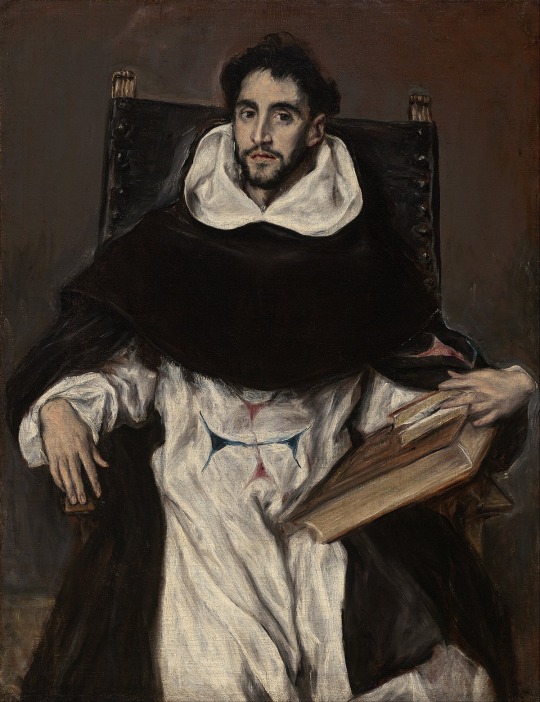
Baroque Era
During the Baroque Era artists often showed sitters looking at the viewer with a variety of emotions, highlighting their personalities and status. Some qualities that are often associated with Baroque art are dynamism, tension, drama, emotional exuberance, movement and intese light and shadow.
Due to portraiture’s high status in the genre heirarchy, a large number of artists turned to portraiture as a means to make money. In Russia, serious portraiture was not around until the rule of Peter the Great under the era of Petrine Art as it was an important way of making income. Important techniques used by artist to strengthen their work and increase the status of their subject and work included two elements. A) The accumulation of figure drawing and B) Figure painting studies portraying facial emotions. This helped speed along the process of painting and widen the range of visible emotions. This can be seen in the works of Rembrandt.
Study of Two Heads
Peter Paul Rubensca. 1609

The Astronomer
Johannes Vermeer1668

The Night Watch
Rembrandt1642

0 notes
Photo
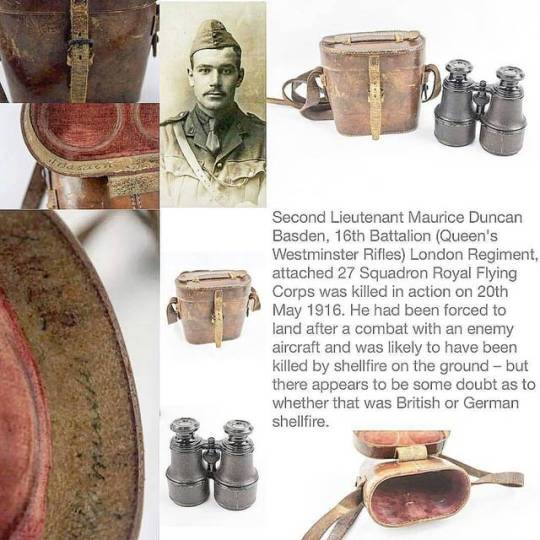
@Regranned from @theretrofactorysg - #Vintage/Antique #Binoculars possibly from the #WW1 Era Officer's Binoculars Adjustable focus The width of the eye pieces is fixed Inscription on the inside of the case lid “II Basden” “W.minster” & some numbers.. Possible address but hard to make out as much is worn away through the passage of time Research shows the son of Duncan Frederick and Margaret Hope (Figgis) Basden, 2nd Lt. Maurice Duncan Basden, 16th (County of London) Battalion, The London Regiment (Queen's Westminster Rifles), born 12 Nov 1894, London. Promoted to 2nd Lt. on 1 Jan 1915. Received Royal Aero Club #Aviators’ Certificate 1816 on a Maurice Farman biplane at Military School, Birmingham on 4 Oct 1915. Killed in action with 27 Squadron, flying Martinsyde G100 (7278), on 20 May 1916, Flanders. Cemetery: Y Farm #Military Cemetery, Bois-Grenier, France He was the first combat loss on a Martinsyde. TSTBF says combat with a Roland, ftl and then shelled, but in The 'Elephants' of Twenty Seven by Paul Leaman (C&C Int Vol 30/1) in the table of all the G100's & G102's, it has this to say about 7278 - Basden brought down by artillery in German lines thought not to have been seriously wounded but killed (probably) by German shellfire. in Reports on #aeroplane and personnel casualties, 1 April to 31 May #1916 (AIR1/843/204/5/369), it says 'Brought down out of control in #combat with Roland and destroyed by artly Sh36 S16CD during patrol.' in #Pilot and observer casualties, RFC France, 1 June #1915 to 30 September 1916 (AIR1/967/204/5/1097), it says 'Shot down by Roland #biplane at Lorgies on patrol and killed after landing by British artillery.' Both sources agree that #Basden was forced to land following a combat with a Roland, but as to whose artillery was actually responsible for destroying his machine and bringing about his death, is unclear. #VintageSG #FleaSG #VintageSG #FleaSG #vintagefleamarket #Alistsg #VintageMarket #FleaMarketSG #sgflea #sgfleamarket #sgshopping #VisitSingapore #sgevents #ExploringSingapore #ExploreSG #Singapore #instasg #igsg #Sgig (at Katong)
#basden#sgevents#aeroplane#exploringsingapore#fleamarketsg#visitsingapore#vintagesg#sgig#vintagemarket#binoculars#fleasg#igsg#pilot#sgfleamarket#1915#vintage#military#sgflea#sgshopping#exploresg#alistsg#instasg#ww1#1916#singapore#biplane#combat#aviators#vintagefleamarket
0 notes
Photo

The Museo Nacional de San Gregorio is a museum in Valladolid, Spain, belonging to the Spanish Ministry of Culture. The museum has an extensive collection sculptural ranging from the Middle Ages to the 19th century from Region of Castile’s churchs that, at 19th-20th c., these were confiscated, and other particular donations, deposits or acquisitions of the state.
The museum was founded as the Provincial Museum of Fine Arts on 4 October 1842. It had its first headquarters at the Palacio de Santa Cruz. On 29 April 1933 it was moved to the Colegio de San Gregorio. Other current seats are in the 16th-century Palacio de Villena and Palacio del Conde de Gondomar
The museum houses works from the 13th to 19th centuries, executed mostly in the Central Spain, and also in other regions historically connected to Spain (Italy, Flanders, Southern America). Artworks include, among the others, a Raising of the Cross by Francisco del Rincon, I Thirst, and The Way of Calvary Gregorio Fernández, Adoration of the Magi by Alonso Berruguete, Lamentation of Christ by Juan de Juni, Penitent Magdalene by Pedro de Mena or the Holy Sepulchre or passage of the Sleepers Alonso de Rozas.
var quads_screen_width = document.body.clientWidth; if ( quads_screen_width >= 1140 ) { /* desktop monitors */ document.write('<ins class="adsbygoogle" style="display:inline-block;width:468px;height:60px;" data-ad-client="pub-9117077712236756" data-ad-slot="9839843423" >'); (adsbygoogle = window.adsbygoogle || []).push({}); }if ( quads_screen_width >= 1024 && quads_screen_width < 1140 ) { /* tablet landscape */ document.write('<ins class="adsbygoogle" style="display:inline-block;width:468px;height:60px;" data-ad-client="pub-9117077712236756" data-ad-slot="9839843423" >'); (adsbygoogle = window.adsbygoogle || []).push({}); }if ( quads_screen_width >= 768 && quads_screen_width < 1024 ) { /* tablet portrait */ document.write('<ins class="adsbygoogle" style="display:inline-block;width:468px;height:60px;" data-ad-client="pub-9117077712236756" data-ad-slot="9839843423" >'); (adsbygoogle = window.adsbygoogle || []).push({}); }if ( quads_screen_width < 768 ) { /* phone */ document.write('<ins class="adsbygoogle" style="display:inline-block;width:468px;height:60px;" data-ad-client="pub-9117077712236756" data-ad-slot="9839843423" >'); (adsbygoogle = window.adsbygoogle || []).push({}); }
During the Holy Week in Valladolid the museum gives 104 images (distributed in the corresponding pasos) to the processions for the brotherhoods.
El Museo Nacional de Escultura reúne una colección de intensa personalidad formada por dos núcleos: obras de género religioso en madera policromada de los siglos XIII al XVIII, y el conjunto de copias artísticas de los siglos XIX y XX, procedente del extinguido Museo Nacional de Reproducciones Artísticas.
Ubicado en varios edificios de gran valor, en el corazón histórico de la ciudad, conforma uno de los espacios urbanos culturales más singulares de nuestro país.
El Museo es de titularidad estatal y gestión exclusiva del Ministerio de Educación, Cultura y Deporte. Administrativamente depende de la Subdirección General de Museos Estatales.
Museo Nacional de Escultura Valladolid, Spain was originally published on HiSoUR Art Collection
0 notes
Text



Breviarium Grimani by miniaturists from the Flemish Ghent-Bruges school, c. 1515
77 notes
·
View notes
Note
If you could keep an eye out for salamanders and gnomes, those are what I like to see
sure! here are four salamanders i've encountered so far:

the salamander as a ram-like animal in a fireplace, in a copy of the 'book of nature' by konrad von megenberg, alsace, c. 1440
Stuttgart, Landesbibl., Cod. med. et phys. 2° 14, fol. 239r
(this library's website is buggy. you need to download the entire manuscript to look at it -> "Ganzes Werk herunterladen")

the salamander as a dragon-like creature on fire, in thomas of cantimpré's 'liber de natura rerum', bavaria, c. 1424
Vatican, Biblioteca Apostolica Vaticana, Pal. lat. 1066, fol. 132v

the salamander as a dog-like, winged creature in a fireplace, in a bestiary, flanders, c. 1270
Getty Museum Collection, Ms. Ludwig XV 3, 95v

the salamander as as a two-legged red animal and as the corresponding animal to the element of fire, in a treatise on the four temperaments, styria, mid-16th c.
Augsburg, Staats- und Stadtbibliothek, 2º Cod 25, fol. 16r
#gnomes are trickier bc i'm not sure what would even fall under that category#salamanders#bestiary#fire#phantastical creatures#ask
354 notes
·
View notes
Text
16th Century Miniature Boxwood Carvings That Fit in the Palm of Your Hand
Carved the size of a palm or smaller, these miniature boxwood carvings featuring religious iconography from the early 16th century have long been a mystery to researchers in the field. It is believed that the entire body of work was created during a 30-year window between 1500 and 1530, somewhere in Flanders or the Netherlands.
The tiny altarpieces, rosaries, and prayer beads are each produced from a single boxwood fragment, incorporating pins smaller than a grass seed that hold the pieces together. Using micro CT scanning and Advanced 3D Analysis Software, curators and conservators of Small Wonders: Gothic Boxwood Miniatures an exhibition at The Art Gallery of Ontario (AGO) in collaboration with the Metropolitan Museum of Art and the Rijksmuseum have gained new insight into the materials and subject matter of each boxwood carving.
Small Wonders: Gothic Boxwood Miniatures will showcase AGO’s collection along with 50 other loaned pieces from other museums and private collections, including some rare carvings that have never been seen in North America. One work, the eleven-bead Chatsworth Rosary (c. 1509-1526), was owned by King Henry VIII and his wife Catherine of Aragon. You can tour the full exhibition yourself at the AGO through January 22, at the Met Cloisters on February 21, 2017, or when the exhibition makes its last stop at the Rijksmuseum on June 15, 2017.
You can also follow AGO on their journey to discovering the mystery behind the boxwood miniatures in the video below, as well as see detailed images from the entire collection on AGO’s website. (via The History Blog)
youtube
Photography by Craig Boyko
Photography by Ian Lefebvre
Photography by Craig Boyko
from Colossal http://ift.tt/2iFsel9
via IFTTT
0 notes
Text
16th Century Miniature Boxwood Carvings That Fit in the Palm of Your Hand
Carved the size of a palm or smaller, these miniature boxwood carvings featuring religious iconography from the early 16th century have long been a mystery to researchers in the field. It is believed that the entire body of work was created during a 30-year window between 1500 and 1530, somewhere in Flanders or the Netherlands.
The tiny altarpieces, rosaries, and prayer beads are each produced from a single boxwood fragment, incorporating pins smaller than a grass seed that hold the pieces together. Using micro CT scanning and Advanced 3D Analysis Software, curators and conservators of Small Wonders: Gothic Boxwood Miniatures an exhibition at The Art Gallery of Ontario (AGO) in collaboration with the Metropolitan Museum of Art and the Rijksmuseum have gained new insight into the materials and subject matter of each boxwood carving.
Small Wonders: Gothic Boxwood Miniatures will showcase AGO’s collection along with 50 other loaned pieces from other museums and private collections, including some rare carvings that have never been seen in North America. One work, the eleven-bead Chatsworth Rosary (c. 1509-1526), was owned by King Henry VIII and his wife Catherine of Aragon. You can tour the full exhibition yourself at the AGO through January 22, at the Met Cloisters on February 21, 2017, or when the exhibition makes its last stop at the Rijksmuseum on June 15, 2017.
You can also follow AGO on their journey to discovering the mystery behind the boxwood miniatures in the video below, as well as see detailed images from the entire collection on AGO’s website. (via The History Blog)
youtube
Photography by Craig Boyko
Photography by Ian Lefebvre
Photography by Craig Boyko
from Colossal http://ift.tt/2iFsel9
http://ift.tt/2iwRKIM
0 notes
Text
16th Century Miniature Boxwood Carvings That Fit in the Palm of Your Hand
Carved the size of a palm or smaller, these miniature boxwood carvings featuring religious iconography from the early 16th century have long been a mystery to researchers in the field. It is believed that the entire body of work was created during a 30-year window between 1500 and 1530, somewhere in Flanders or the Netherlands.
The tiny altarpieces, rosaries, and prayer beads are each produced from a single boxwood fragment, incorporating pins smaller than a grass seed that hold the pieces together. Using micro CT scanning and Advanced 3D Analysis Software, curators and conservators of Small Wonders: Gothic Boxwood Miniatures an exhibition at The Art Gallery of Ontario (AGO) in collaboration with the Metropolitan Museum of Art and the Rijksmuseum have gained new insight into the materials and subject matter of each boxwood carving.
Small Wonders: Gothic Boxwood Miniatures will showcase AGO’s collection along with 50 other loaned pieces from other museums and private collections, including some rare carvings that have never been seen in North America. One work, the eleven-bead Chatsworth Rosary (c. 1509-1526), was owned by King Henry VIII and his wife Catherine of Aragon. You can tour the full exhibition yourself at the AGO through January 22, at the Met Cloisters on February 21, 2017, or when the exhibition makes its last stop at the Rijksmuseum on June 15, 2017.
You can also follow AGO on their journey to discovering the mystery behind the boxwood miniatures in the video below, as well as see detailed images from the entire collection on AGO’s website. (via The History Blog)
youtube
Photography by Craig Boyko
Photography by Ian Lefebvre
Photography by Craig Boyko
0 notes
Photo

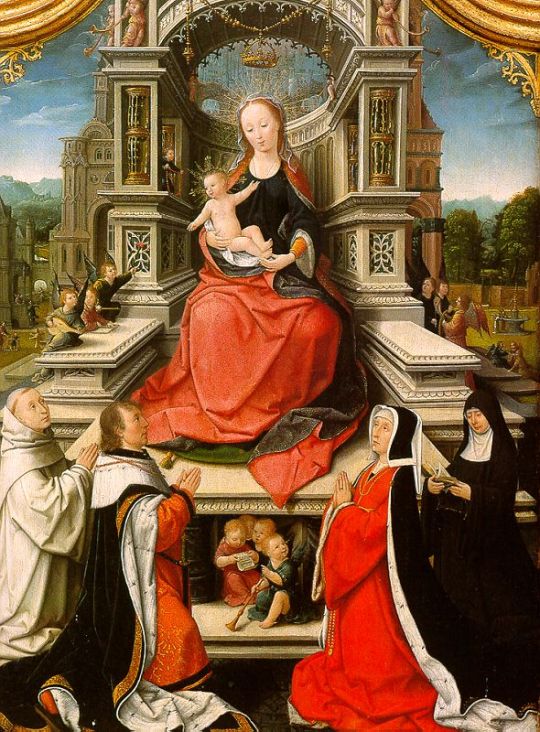
The Le Cellier altarpiece by Jehan, aka Jean, Bellegambe 1509
#Jehan Bellegambe#jean bellegambe#1509#1500s#16th century#mdp16th c.#religious art#flemish#Flanders#16th c. flanders
30 notes
·
View notes
Text

Korona Welser von Langemantel by Abraham del Hele, 1592
40 notes
·
View notes